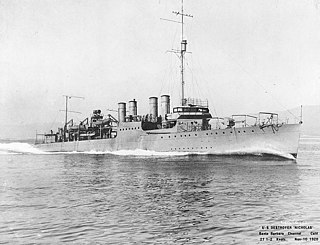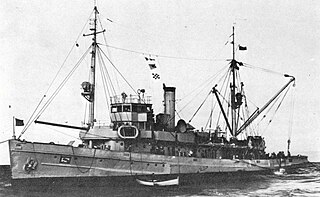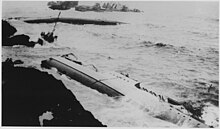
USS Somers (DD-301), a Clemson-class destroyer, engaged in peacetime operations with the Pacific Fleet from 1920 until she was scrapped under the London Naval Treaty in 1930. She was the fourth ship of the United States Navy named for Richard Somers.

USS Jacob Jones (DD-130), named for Commodore Jacob Jones USN (1768–1850), was a Wickes-class destroyer. She was sunk by a German submarine in 1942 during World War II.

The Honda Point disaster was the largest peacetime loss of U.S. Navy ships. On the evening of September 8, 1923, seven destroyers, while traveling at 20 knots (37 km/h), ran aground at Honda Point, a few miles from the northern side of the Santa Barbara Channel off Point Arguello on the Gaviota Coast in Santa Barbara County, California. Two other ships grounded, but were able to maneuver free off the rocks. Twenty-three sailors died in the disaster.

USS Farragut (DD-300) was a Clemson-class destroyer built for the United States Navy during World War I.

The first USS Philip (DD–76) was a Wickes-class destroyer in the United States Navy during World War I, later transferred to the Royal Navy as HMS Lancaster. She was named for John Woodward Philip.

The first USS Laub (DD-263) was a Clemson-class destroyer in the United States Navy and transferred to the Royal Navy where she served as HMS Burwell (H94) during World War II. She was named for Henry Laub.

USS Edwards (DD-265) was a Clemson-class destroyer in the United States Navy and transferred to the Royal Navy where she served as HMS Buxton (H96) and later in the Royal Canadian Navy during World War II.

USS Sinclair (DD-275) was a Clemson-class destroyer in the United States Navy. She was named for Captain Arthur Sinclair.

USS Henshaw (DD-278) was a Clemson-class destroyer in the United States Navy following World War I. She was named for Secretary of the Navy David Henshaw.

USS Fuller (DD-297) was a Clemson-class destroyer built for the United States Navy during World War I.

USS John Francis Burns (DD-299) was a Clemson-class destroyer built for the United States Navy during World War I.

USS Stoddert (DD-302/AG-18) was a Clemson-class destroyer in the United States Navy following World War I. It was named for Benjamin Stoddert.

USS William Jones (DD-308), a Clemson-class destroyer in the United States Navy, named for William Jones.

The third USS Woodbury (DD-309) was a Clemson-class destroyer in the United States Navy. She was named for Levi Woodbury.

The first USS S. P. Lee (DD-310) was a Clemson-class destroyer in the United States Navy following World War I. She was named for Samuel Phillips Lee.

USS Nicholas (DD-311) was a Clemson-class destroyer in the United States Navy following World War I. She was the first Navy ship named for Samuel Nicholas (1744–1790), the first Commandant of the United States Marine Corps.

The first USS Young (DD-312) was a Clemson-class destroyer in the United States Navy following World War I. She was named for John Young.

USS Sicard (DD-346/DM-21/AG-100) was a Clemson-class destroyer in the United States Navy following World War I. She was named for Montgomery Sicard.

USS George (DE-697) was a Buckley-class destroyer escort. She was the second ship of the United States Navy named after Seaman Second Class Eugene F. George (1925–1942), who was posthumously awarded the Navy Cross for his heroism on USS San Francisco at the Naval Battle of Guadalcanal.

The first USS Ortolan(AM-45/ASR-5) was a Lapwing-class minesweeper in the United States Navy. She was later converted to a submarine rescue ship. She was named after the ortolan, a European bunting.




















